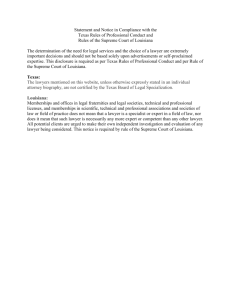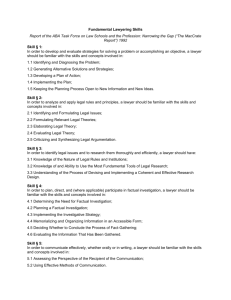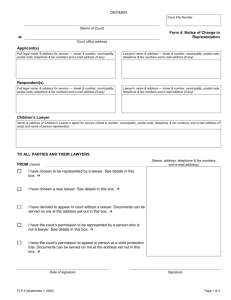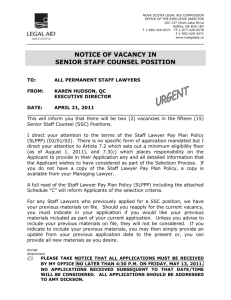The Proposed Model Rules of Professional Conduct include a
advertisement
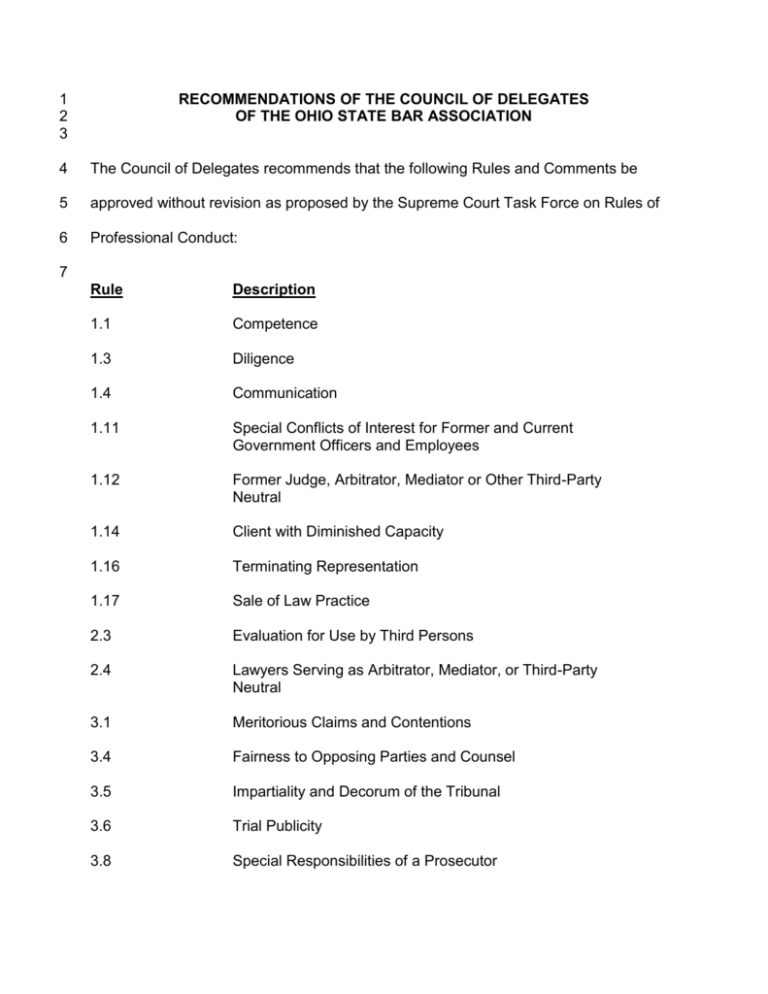
1 2 3 RECOMMENDATIONS OF THE COUNCIL OF DELEGATES OF THE OHIO STATE BAR ASSOCIATION 4 The Council of Delegates recommends that the following Rules and Comments be 5 approved without revision as proposed by the Supreme Court Task Force on Rules of 6 Professional Conduct: 7 Rule Description 1.1 Competence 1.3 Diligence 1.4 Communication 1.11 Special Conflicts of Interest for Former and Current Government Officers and Employees 1.12 Former Judge, Arbitrator, Mediator or Other Third-Party Neutral 1.14 Client with Diminished Capacity 1.16 Terminating Representation 1.17 Sale of Law Practice 2.3 Evaluation for Use by Third Persons 2.4 Lawyers Serving as Arbitrator, Mediator, or Third-Party Neutral 3.1 Meritorious Claims and Contentions 3.4 Fairness to Opposing Parties and Counsel 3.5 Impartiality and Decorum of the Tribunal 3.6 Trial Publicity 3.8 Special Responsibilities of a Prosecutor 8 9 3.9 Advocate in Nonadjudicative Proceedings 4.2 Communication with Person Represented by Counsel 4.3 Dealing with Unrepresented Person 5.1 Responsibilities of Partners, Manager, and Supervisory Lawyers 5.2 Responsibilities of a Subordinate Lawyer 5.3 Responsibilities Regarding Nonlawyer Assistants 5.4 Professional Independence of a Lawyer 5.5 Practice of Law; Multijurisdictional Practice of Law 5.6 Restrictions on Right to Practice 5.7 Responsibilities Regarding Law-related Services 6.5 Nonprofit and Court-Annexed Limited Legal Service Programs 7.3 Direct Contact with Prospective Clients 7.6 Political Contributions to Obtain Government Legal Engagements or Appointments by Judges [Not Recommended; See Reporter’s Note] 8.5 Disciplinary Authority; Choice of Law The Council of Delegates recommends adoption of the following Rules and comments 10 with the changes noted: 11 Rule 1.2 12 (1) In subsection (c), delete lines 17-22 and insert the following: 13 “(c) A lawyer may limit the scope of representation if the limitation is 14 reasonable under the circumstances and the client gives informed consent.” -2- 15 (2) In the comments, delete lines 89-115 and insert, “The scope of services to be 16 provided by a lawyer may be limited by agreement with the client or by the 17 terms under which the lawyer’s services are made available to the client. 18 When a lawyer has been retained by an insurer to represent an insured, for 19 example, the representation may be limited to matters related to the 20 insurance coverage. A limited representation may be appropriate because 21 the client has limited objectives for the representation. In addition, the terms 22 upon which representation is undertaken may exclude specific means that 23 might otherwise be used to accomplish the client’s objectives. Such 24 limitations may exclude actions that the client thinks are too costly or that the 25 lawyer regards as repugnant or imprudent. 26 Although this Rule affords the lawyer and client substantial latitude to 27 limit the representation, the limitation must be reasonable under the 28 circumstances. If, for example, a client’s objective is limited to securing 29 general information about the law the client needs in order to handle a 30 common and typically uncomplicated legal problem, the lawyer and client may 31 agree that the lawyer’s services will be limited to a brief telephone 32 consultation. Such a limitation, however, would not be reasonable if the time 33 allotted was not sufficient to yield advice upon which the client could rely. 34 Although an agreement for a limited representation does not exempt a lawyer 35 from the duty to provide competent representation, the limitation is a factor to 36 be considered when determining the legal knowledge, skill, thoroughness and 37 preparation reasonably necessary for the representation. See Rule 1.1. -3- 38 All agreements concerning a lawyer’s representation of a client must accord 39 with the Rules of Professional Conduct and other law. See, e.g., Rules 1.1, 40 1.8 and 5.6.” 41 Rule 1.5 42 (1) Delete subsection (b) (lines 18-24) and insert the following: “Either before a 43 lawyer undertakes a representation or within a reasonable time after 44 commencing a representation, a lawyer shall communicate to the client both 45 the scope of the representation the lawyer undertakes and the basis or rate of 46 the fee and expenses for which the client will be responsible for the lawyer’s 47 services. Likewise, a lawyer shall promptly communicate to the client any 48 changes in the basis or rate of the fee or expenses.” 49 (2) the word “A”; and delete line 95 in its entirety. 50 51 In Comment [2], delete lines 84 through line 92; delete line 94 beginning with Rule 1.6 52 At line 13 on Page A-43 delete “illegal” and insert “criminal”. 53 Add comment [7]. “In a matter involving a fee dispute among lawyers arising under 54 Rule 1.5(e), or otherwise, where the client has no substantial financial interest in the 55 resolution of the matter, client confidences and secrets may only be disclosed during 56 a mediation or arbitration provided pursuant to Rule 1.5(f). Concerning fees, client 57 confidences or secrets may be disclosed if the controversy over the amount or 58 liability for the fee is between the lawyer and the client.” -4- 59 Rule 1.7 60 In line 2 of Rule 1.7 at the beginning of the sentence, insert the words, “Unless 61 otherwise required by law.” 62 Delete lines 10 through 12 and substitute the following therefor: 63 “(b) Notwithstanding the existence of a concurrent conflict of interest under division 64 (a) of this rule, a lawyer may represent a client if all of the following apply:” 65 In Comment [18] insert the following at line 195: 66 “A lawyer representing a fiduciary does not, solely by that representation, engage in 67 multiple representation of other parties to whom the fiduciary owes fiduciary duties.” 68 Rule 1.8 69 In line 4, delete the words, “enter into a business transaction with a client or”. 70 In line 73, after the word “disclose”, insert the words “discoverable and non- 71 confidential”. 72 In line 76, delete the words, “case or”. 73 74 75 Rule 1.9 In lines 4 and 7 “substantially” should not be italicized since it is not a defined term. Rule 1.10 76 Delete lines 17 through 20. 77 Add Comment [9] at line 141: 78 “[9] ‘Substantially related’ as used in Rule 1.10(b)(1) and (d) is defined in Comment 79 [3] of Rule 1.9 (see Rule 1.0, Comment [11]).” 80 Rule 1.13 81 Delete the words, “or reasonably should know” in line 7. -5- 82 Delete lines 16 and 17 and substitute the following: 83 “(c) Except as provided in paragraph (d), if 84 “(1) despite the lawyer’s efforts in accordance with paragraph (b) the highest 85 authority that can act on behalf of the organization insists upon or fails to address 86 in a timely and appropriate manner an action, or a refusal to act, that is clearly a 87 violation of law, and 88 “(2) the lawyer reasonably believes that the violation is reasonably certain to 89 result in substantial injury to the organization, then the lawyer may reveal 90 information relating to the representation whether or not Rule 1.6 permits such 91 disclosure, but only if and to the extent the lawyer reasonably believes necessary 92 to prevent substantial injury to the organization. 93 “(d) Paragraph (c) shall not apply with respect to information relating to a lawyer’s 94 representation of an organization to investigate an alleged violation of law, or to 95 defend the organization or an officer, employee or other constituent associated 96 with the organization against a claim arising out of an alleged violation of law. 97 (e) A lawyer who reasonably believes that he or she has been discharged 98 because of the lawyer’s action taken pursuant to paragraph (b) or (c), or who 99 withdraws under circumstances that require or permit the lawyer to take action 100 under either of those paragraphs, shall proceed as the lawyer reasonably 101 believes necessary to assure that the organization’s highest authority is informed 102 of the lawyer’s discharge or withdrawal.” -6- 103 Rule 1.15 104 In line 4, delete the words, “separate interest bearing” and insert the word “trust”. 105 In line 9, delete the word “seven” and insert the word “three”. 106 Delete lines 23 through 31. 107 Rule 1.18 108 Delete everything after “matter” in line 11 through line 25. 109 Add Comment [10] at line 84: 110 “[10] ‘Substantially related’ as used in Rule 1.18(c) is defined in Comment [3] of 111 Rule 1.9. (See Rule 1.0, Comment [11]).” 112 113 114 Rule 2.1 Delete the second sentence, beginning in line 3 and ending in line 5. Rule 3.3 115 Delete lines 18 through 21 and insert the words, “The duties stated in Divisions 116 (a) and (b) of this rule continue to the conclusion of the proceeding.” 117 118 119 Rule 3.7 Insert “(b)” in line 5 before “Except”. Rule 4.1 120 Delete lines 5 and 6 and insert the words “(b) fail to disclose a material fact to a 121 third person when disclosure is necessary to avoid assisting a criminal or 122 fraudulent act by a client, unless disclosure is prohibited by Rule 1.6.” 123 Rule 4.4 124 In Comment [2], delete lines 20, beginning with the word “Generally”, through line 125 35, ending with the word “request”. -7- 126 127 128 Rule 6.2 In line 2, delete the word “tribunal” and insert the word “court”. Rule 7.1 129 In line 3, delete the comma and the word “non-verifiable” and insert the word “or” 130 between the words “false” and “misleading”. 131 Rule 7.2 132 At the end of line 5, insert “A lawyer shall not seek employment in connection 133 with matters in which the lawyer or law firm does not intend to actively participate 134 in the representation, but that the lawyer or law firm intends to refer to other 135 counsel, except that this provision shall not apply to organizations listed in Rule 136 7.2 (b)(2) and (3) or if the advertisement is in furtherance of the transactions 137 described in Rule 1.17.” 138 Rule 7.4 139 After line 12, insert a new Division: “(d) a lawyer engaged in trademark practice 140 before the United States Patent and Trademark Office may use the designation 141 ‘Trademark’, ‘Trademark Attorney’ or a substantially similar designation.” 142 In line 12, delete “(d)” and insert “(e)”. 143 In Comment [2], line 30, insert “and (d)” after “(c)”. In line 31, insert “and 144 Trademark” after “admiralty”. In line 31, delete “maritime” and in line 32, delete 145 “commerce and”. 146 147 Rule 7.5 In line 4, delete “firm name”. -8- 148 In Comment [1], at line 30, after “nonlawyer”, insert, “A lawyer or law firm may 149 also be designated by a distinctive website address or comparable professional 150 designation.” 151 In Comment [4], in line 44, delete “Practitioners” and insert, “lawyers”. 152 Rule 8.1 153 Delete the proposed rule in its entirety and substitute therefor: 154 “An applicant for admission to the bar, or a lawyer in connection with a bar 155 admission application or in connection with a disciplinary matter, shall not: 156 (a) knowingly make a false statement of material fact; or 157 (b) fail to disclose a fact necessary to correct a misapprehension known by the 158 person to have arisen in the matter, or knowingly fail to respond to a lawful 159 demand for information from an admissions or disciplinary authority, except that 160 this rule does not require disclosure of information otherwise protected by Rule 161 1.6. 162 Delete the proposed Comment in its entirety and substitute therefor: 163 “[1] The duty imposed by this Rule extends to persons seeking admission to the 164 bar as well as to lawyers. Hence, if a person makes a material false statement in 165 connection with an application for admission, it may be the basis for subsequent 166 disciplinary action if the person is admitted, and in any event may be relevant in a 167 subsequent admission application. The duty imposed by this Rule applies to a 168 lawyer's own admission or discipline as well as that of others. Thus, it is a -9- 169 separate professional offense for a lawyer to knowingly make a 170 misrepresentation or omission in connection with a disciplinary investigation of 171 the lawyer's own conduct. Paragraph (b) of this Rule also requires correction of 172 any prior misstatement in the matter that the applicant or lawyer may have made 173 and affirmative clarification of any misunderstanding on the part of the 174 admissions or disciplinary authority of which the person involved becomes 175 aware. 176 [2] This Rule is subject to the provisions of the fifth amendment of the United 177 States Constitution and corresponding provisions of state constitutions. A person 178 relying on such a provision in response to a question, however, should do so 179 openly and not use the right of nondisclosure as a justification for failure to 180 comply with this Rule. 181 [3] A lawyer representing an applicant for admission to the bar, or representing a 182 lawyer who is the subject of a disciplinary inquiry or proceeding, is governed by 183 the rules applicable to the client-lawyer relationship, including Rule 1.6 and, in 184 some cases, Rule 3.3.” 185 186 Rule 8.2 In line 4, delete “judicial officer” and insert “judge or magistrate”. - 10 - 187 Rule 8.3 188 Delete Divisions (a) and (b), lines 2 through 8, and substitute therefor the 189 following: 190 “(a) A lawyer who possesses unprivileged knowledge that another lawyer has 191 committed a violation of the Rules of Professional Conduct that raises a 192 substantial question as to that lawyer's honesty, trustworthiness or fitness as a 193 lawyer in other respects, shall inform the appropriate professional authority. 194 (b) A lawyer who possesses unprivileged knowledge that a judge or magistrate 195 has committed a violation of applicable rules of judicial conduct that raises a 196 substantial question as to the judge's or magistrate’s fitness for office shall inform 197 the appropriate authority.” 198 Delete the proposed Comment in its entirety and substitute therefor: 199 “[1] Self-regulation of the legal profession requires that members of the 200 profession initiate disciplinary investigation when they possess unprivileged 201 knowledge of a violation of the Rules of Professional Conduct. Lawyers have a 202 similar obligation with respect to judicial misconduct. An apparently isolated 203 violation may indicate a pattern of misconduct that only a disciplinary 204 investigation can uncover. Reporting a violation is especially important where the 205 victim is unlikely to discover the offense. 206 [2] [Reserved] - 11 - 207 [3] If a lawyer were obliged to report every violation of the Rules, the failure to 208 report any violation would itself be a professional offense. Such a requirement 209 existed in many jurisdictions but proved to be unenforceable. This Rule limits the 210 reporting obligation to those offenses that a self-regulating profession must 211 vigorously endeavor to prevent. A measure of judgment is, therefore, required in 212 complying with the provisions of this Rule. The term "substantial" refers to the 213 seriousness of the possible offense and not the quantum of evidence of which 214 the lawyer is aware. A report should be made to the bar disciplinary agency 215 unless some other agency, such as a peer review agency, is more appropriate in 216 the circumstances. Similar considerations apply to the reporting of judicial 217 misconduct. 218 [4] The duty to report professional misconduct does not apply to a lawyer 219 retained to represent a lawyer whose professional conduct is in question. Such a 220 situation is governed by the Rules applicable to the client-lawyer relationship. 221 [5] Information about a lawyer's or judge's misconduct or fitness may be received 222 by a lawyer in the course of that lawyer's participation in an approved lawyers or 223 judges assistance program. In that circumstance, providing for an exception to 224 the reporting requirements of paragraphs (a) and (b) of this Rule encourages 225 lawyers and judges to seek treatment through such a program. Conversely, 226 without such an exception, lawyers and judges may hesitate to seek assistance 227 from these programs, which may then result in additional harm to their 228 professional careers and additional injury to the welfare of clients and the public. - 12 - 229 These Rules do not otherwise address the confidentiality of information received 230 by a lawyer or judge participating in an approved lawyers’ assistance program; 231 such an obligation, however, may be imposed by the rules of the program or 232 other law.” 233 Rule 8.4 234 In line 5, delete the word “illegal” and insert the word “criminal”. 235 Delete lines 17 and 18. 236 In line 27, delete the word “illegal” and insert the word “criminal”. 237 Preamble 238 Insert the following as Comment [7] at line 48: 239 “[7] Many of a lawyer's professional responsibilities are prescribed in the Ohio 240 Rules of Professional Conduct, as well as substantive and procedural law. 241 However, a lawyer is also guided by personal conscience and the approbation of 242 professional peers. A lawyer should strive to attain the highest level of skill, to 243 improve the law and the legal profession and to exemplify the legal profession's 244 ideals of public service.” 245 246 247 Rule 1.0 In Comment [6] delete the reference to Rule 1.2(c) at line 114. Minority Report - 13 - 248 249 250 The Council of Delegates also voted to submit, but not approve, a minority report on Rules 1.2 and 1.5; that report follows. Rules 1.2 and 1.5, as proposed by the task force, mandate that a lawyer confirm, 251 in writing, both the scope of the representation of the client and the agreement 252 concerning the fees and expenses the lawyer will charge the client. The rule mandates 253 that the lawyer confirm these matters, in writing, within a reasonable time after 254 commencing the representation. 255 256 A minority of the OSBA subcommittee believe the Supreme Court of Ohio should adopt the rule as proposed by the task force. 257 Still other members of the subcommittee, also in the minority, believe the 258 Supreme Court of Ohio should increase the amount of fee that triggers the requirement 259 in Rule 1.2 as proposed by the task force to confirm, in writing, the scope of 260 representation and the agreement concerning the fees and expenses the lawyer will 261 charge the client. Those members believe the Supreme Court of Ohio should change 262 the amount from $500.00 to a substantially higher amount, such as $2,500.00. - 14 -
